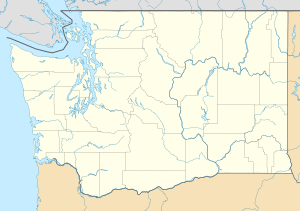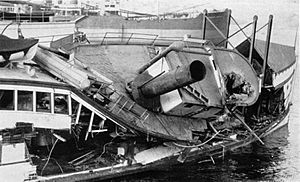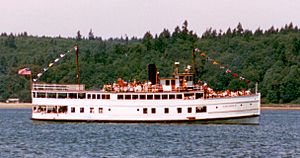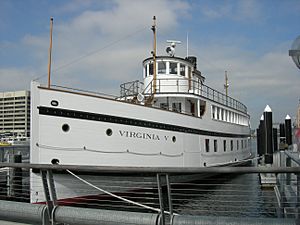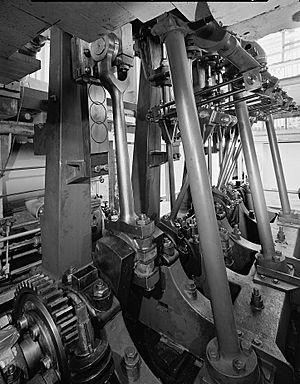Virginia V facts for kids
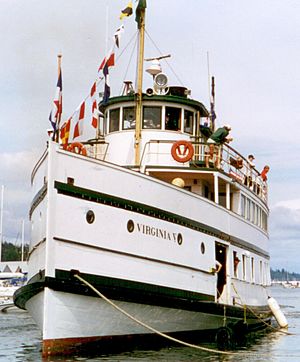
Virginia V, at Olympia, Washington, 4 July 1996
|
|
| History | |
|---|---|
| Name | Virginia V |
| Owner | West Pass Transportation Company |
| Operator | West Pass Transportation Company |
| Route | West Pass Route |
| Builder | Anderson & Company |
| Laid down | October 1921 |
| Launched | 9 March 1922 |
| Completed | June 1922 |
| Maiden voyage | 11 June 1922 |
| In service | 11 June 1922 |
| Identification |
|
| Nickname(s) | Virginia Vee |
| Status | Operational Museum Ship |
| General characteristics | |
| Type | Passenger steamer |
| Tonnage | 99 Gross, 67 Net |
| Displacement | Approximately 150 tons |
| Length | 125 ft (38 m) on deck |
| Beam | 24 feet (7.3 m) |
| Draft | 8 feet (2.4 m) |
| Decks | 4 |
| Installed power | 400 hp (300 kW) triple-expansion steam engine |
| Speed | 16.2 kn (30.0 km/h; 18.6 mph) |
| Crew | 7 |
|
Virginia V (steamer)
|
|
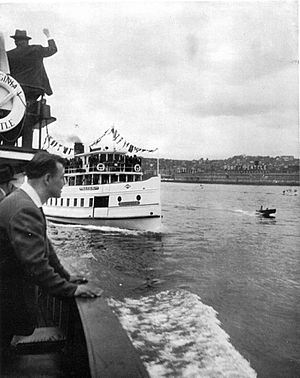
Virginia V leading Sightseer, May 22, 1948.
|
|
| Location | 860 Terry Avenue North, Seattle, WA 98109 |
| Built | 1922 |
| Architect | Anderson & Co., Matthew Anderson |
| NRHP reference No. | 73001875 |
| Significant dates | |
| Added to NRHP | 24 April 1973 |
| Designated NHL | 5 October 1992 |
The Virginia V is a special steamship because it is the last working example of a "Mosquito Fleet" steamer from Puget Sound. These small ships used to carry people and goods between the many islands and ports in Washington state. This was important in the late 1800s and early 1900s.
The Virginia V is now a Seattle landmark and a National Historic Landmark. This means it is a very important part of history.
Her first job was to travel between Tacoma and Seattle. This route went along the West Pass, also called Colvos Passage, which is between Vashon Island and the Kitsap Peninsula.
Today, the ship is still working! You can find her at Heritage Wharf in Lake Union Park in Seattle.
Contents
- History of the Virginia V
- The West Pass Transportation Company
- The Virginia Boats
- Building the Virginia V
- The Big Storm of 1934
- Camp Sealth and the Camp Fire Girls
- New Owners and Challenges
- Captain Howell Parker and the Great Steamboat Race
- Puget Sound Excursion Lines
- Northwest Steamship Company
- Steamer Virginia V Foundation
- Big Restoration Project (1995–2001)
- Virginia V Today
- Engine and Boiler
- See also
History of the Virginia V
The West Pass Transportation Company
At the start of the 1900s, many towns around Puget Sound, especially on the islands, needed boats. These boats delivered supplies and provided transportation. The main shipping route from Seattle to Tacoma was on the east side of Vashon Island.
However, people living along Colvos Passage and on the west side of Vashon Island were not happy. Their boat service was not reliable. So, in 1910, Captain Nelse Christensen and John Holm started their own company. They called it the West Pass Transportation Company.
They bought a 54-foot (16 m) long gasoline-powered tugboat named Virginia Merrill. They changed its name to Virginia and made it into a small ferry.
The Virginia Boats
The first Virginia was replaced in 1912 by Virginia II. This ship was 77-foot (23 m) long and had a 110 hp (82 kW) gasoline engine. In 1914, the company bought a 92-foot (28 m) steamship called Typhoon and renamed it Virginia III.
Later, in 1918, they bought another steamship, Tyrus, which was 98-foot (30 m) long. In 1920, they renamed it Virginia IV and put it on the West Pass route.
Building the Virginia V
In 1921, a company called Anderson & Company in Maplewood, Washington, started building the Virginia V. The ship was made from strong, old-growth fir wood found nearby.
She was launched on March 9, 1922. Then, she was taken to downtown Seattle to have her engine and steam system installed. The engine from Virginia IV was moved and put into the new Virginia V.
On June 11, 1922, the Virginia V made her very first trip. She sailed from Elliott Bay in Seattle to Tacoma, going down the West Pass. She continued to make this trip almost every day until 1938.
The Big Storm of 1934
On October 21, 1934, a very strong storm hit Puget Sound. The Virginia V was trying to dock at Olalla, Washington, when the storm hit hard. The powerful winds pushed the ship against the dock. Waves crashed the ship into the dock's wooden posts.
This caused a lot of damage, almost destroying the upper parts of the ship. The Virginia V had to be rebuilt at the Lake Washington Shipyard. She was back in service on December 5, 1934.
Camp Sealth and the Camp Fire Girls
Every summer for many years, from 1922 to 1970, the Virginia V had a special job. She carried girls from Seattle to Camp Sealth on Vashon Island. This was for the Camp Fire Girls organization.
Thousands of women who grew up in the Northwest remember riding on "Virginia Vee" (as they called her). For them, it was the start of an exciting camping adventure.
New Owners and Challenges
The West Pass Transportation Company closed down in 1942. The Virginia V had been sailing between Seattle and Fort Worden. She was then moved to the Columbia River. For a short time, she sailed between Portland and Astoria. This made her the last passenger ship to work on both Puget Sound and the Columbia River.
However, her time on the Columbia River was not successful. Her owners could not pay the crew. So, the ship was legally taken and sold in Vancouver, Washington. O.H. "Doc" Freeman and Joe Boles from Seattle bought her. Less than a year later, they sold her to Jack Katz and Captain Howell Parker.
Captain Howell Parker and the Great Steamboat Race
Captain Parker and his wife, Mary, operated the Virginia V. Mary worked as the steward and purser. During World War II, they carried war workers between Poulsbo, Washington, and the Keyport Naval Torpedo Station.
After the war, the Parkers continued to use the Virginia V for fun trips around Puget Sound. In 1948, the Puget Sound Maritime Historical Society was formed to save the history of ships in the Northwest. To get attention, they held a race!
The race was between the Virginia V and another ship, the Grayline Sightseer. The Great Steamboat Race happened on May 22, 1948. The course was 5-mile (8.0 km) long, going along the Seattle waterfront. The Virginia V won the race by just a little bit!
Puget Sound Excursion Lines
In 1954, Captain Phillip Luther bought the Virginia V. He owned Puget Sound Excursion Lines. In 1956, Captain Luther sold her to Charles McMahon. McMahon worked hard to fix up the Virginia V. He continued to use her for commercial trips around Puget Sound.
In 1958, James F. "Cy" Devenny bought most of Puget Sound Excursion Company. He took over running the Virginia V and other small boats. One of these was the J.E. Overlade, which was built in 1928. It was also one of the last ships from the Mosquito Fleet. Devenny renamed her Virginia VI to go with the more famous Virginia V.
Northwest Steamship Company
In 1968, some people who loved steamboats started the Northwest Steamship Company. They raised money to buy the Virginia V from Puget Sound Excursion Company.
In 1973, the ship was placed on the National Register of Historic Places. This meant she was recognized as very important historically. But even with this recognition, it was hard for the owners to keep her running as a business.
Steamer Virginia V Foundation
To help save the Virginia V, a non-profit group was formed in 1976. It was called the Steamer Virginia V Foundation. The Foundation bought the ship on September 30, 1980.
Big Restoration Project (1995–2001)
In 2002, the Foundation was able to put the Virginia V back into service. This happened after a huge restoration project that lasted six years and cost $6.5 million.
The project included rebuilding the steam engine and building a new boiler. They also rebuilt the upper parts of the ship using traditional fir wood planks. In 2001, the Foundation received an award for all their hard work on the restoration.
Virginia V Today
Since 2002, the Virginia V has been busy! She offers public trips and private charters. She also visits local maritime festivals all around Puget Sound.
Engine and Boiler
The Virginia V's engine is a special type called a triple-expansion, double-acting, reciprocating steam engine. It is the original engine that was put in the ship in 1922. This engine was actually taken from the Virginia IV.
The parts for this engine were made in 1904 in Seattle. It was one of two identical engines built for the Army. The Virginia V's engine was put together and installed in the ship Tyrus in 1907.
- Engine Power: 400 horsepower (300 kW)
- Maximum Speed: About 200 rotations per minute
- Cylinder Sizes: 10.5 inches (270 mm), 16.75 inches (425 mm), and 28.5 inches (720 mm) (for high, intermediate, and low pressure)
- Stroke: 18 inches (460 mm)
The original boiler was replaced in 2000 with a new one. Both boilers used oil as fuel. The ship first burned heavy bunker fuel. In 2002, it was changed to burn #2 Diesel fuel.
Sometimes, the engine makes a noise called "The Squeak." No one knows exactly why it happens, but it might be from the low-pressure valve. Engineers have even started a fun fund where visitors can donate if they want to ask about the squeak!
- Working Pressure: 200 pounds per square inch (1,400 kPa)
- Steam Capacity: 10,000 lb (4,500 kg) of steam per hour
- Fuel Type: #2 Diesel Oil
- Fuel Use: About 20–50 US gallons (80–200 L) per hour
See also


